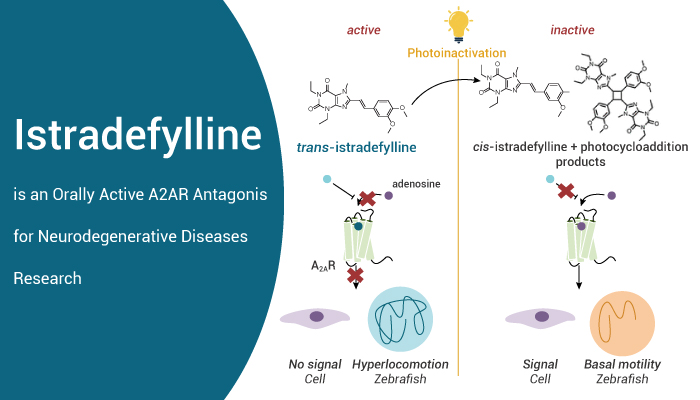Adenosine receptors (ARs) are a group of G protein-coupled receptors that play a crucial role in mediating the physiological actions of adenosine. In Parkinson’s disease, the dysregulation of adenosine signaling has been implicated in the neurodegenerative process. Istradefylline, a potent and selective adenosine A2A receptor antagonist, has shown promising results in experimental models of Parkinson’s disease.
Adenosine Receptors and Parkinson’s Disease: Adenosine receptors, including A2A receptors, are involved in the regulation of normal and pathological processes. In Parkinson’s disease, targeting A2A receptors has gained attention due to their potential role in modulating dopamine and neuroinflammation.

Istradefylline: Targeting Adenosine Receptors for Parkinson’s Disease
Istradefylline is a very potent, selective and orally active adenosine A2A receptor antagonist with Ki of 2.2 nM in experimental models of Parkinson’s disease.
In vitro experiments have demonstrated that Istradefylline effectively inhibits the induction of astrogliosis, a hallmark of neuroinflammation, in primary rat striatal astrocytes. The binding affinity of Istradefylline for A1, A2A, and A3 receptors in human and animal models has also been determined. Istradefylline exhibits high affinity for A2A receptors, with a Ki value of 2.2 nM, and a 70-fold greater affinity for A2A receptors compared to A1 receptors. This selectivity is important for minimizing potential side effects associated with non-selective adenosine receptor antagonists.
In Vivo, Pre-treatment with Istradefylline in animal models attenuates dopamine depletion in the striatum, a key feature of Parkinson’s disease. Istradefylline has also shown efficacy in reversing catalepsy induced by CGS21680 and reserpine. And it exhibits potency greater than other adenosine antagonists and dopamine agonist drugs. Additionally, Istradefylline, in combination with L-dopa, produces significant improvements in motor disability without exacerbating dyskinesia.
In conclusion, Istradefylline is a very potent, selective and orally active adenosine A2A receptor antagonist. So it holds promise as a therapeutic option for Parkinson’s disease.
Reference:
[1]. J Neurosci. 2001 May 15;21(10):RC143.
[2]. Psychopharmacology (Berl). 1999 Nov;147(1):90-5.
[3]. Exp Neurol. 2000 Apr;162(2):321-7.